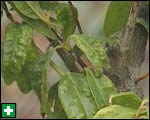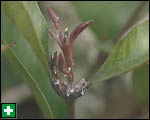Plant
Doctor Archive

Pohutukawa
 My
pohutukawa tree has bubbles on its new leaves. What causes this? My
pohutukawa tree has bubbles on its new leaves. What causes this?
 This
is very common on pohutukawa and rata, and it's caused by an absolutely
fascinating native insect called a psyllid. It also occurs on the
karo — or the pittosporum. On pittosporum, the pits are made
by a different species of psyllid, namely the pittosporum psyllid. This
is very common on pohutukawa and rata, and it's caused by an absolutely
fascinating native insect called a psyllid. It also occurs on the
karo — or the pittosporum. On pittosporum, the pits are made
by a different species of psyllid, namely the pittosporum psyllid.
This one is totally host-specific,
as is the one on the pohutukawa. It only goes for metrosideros.
 The adults, which you can see on the new foliage, look a bit
like aphids, and they only lay eggs on the new leaves. Out of the
eggs come little nymphs, and they put their stylets into the leaf
material, and then the leaf forms the bubble.
The adults, which you can see on the new foliage, look a bit
like aphids, and they only lay eggs on the new leaves. Out of the
eggs come little nymphs, and they put their stylets into the leaf
material, and then the leaf forms the bubble.
These psyllids excrete
crystalline sugar, a crystalline form of honeydew, which is normally
picked up by ants which take the bits of sugar back to their nest.
At the same time, these ants will protect the psyllids that live
on the leaf, and they also protect the leaf on which the psyllids
live. That means no chewers will come and take bites out of the
leaf.
 As for the acmena hedge, a few years ago a foreign species of
psyllid got into NZ, and it's hammering the new growth of its host.
It doesn't make any dimples, but it's free-living. It can get very
messy with honeydew and sooty mould, but this psyllid does not seem
to have any ecological relationship with ants. So whilst the damage
looks spectacular, it does not seem to harm the fast-growing acmena
that much.
As for the acmena hedge, a few years ago a foreign species of
psyllid got into NZ, and it's hammering the new growth of its host.
It doesn't make any dimples, but it's free-living. It can get very
messy with honeydew and sooty mould, but this psyllid does not seem
to have any ecological relationship with ants. So whilst the damage
looks spectacular, it does not seem to harm the fast-growing acmena
that much.
If you have major problems
with psyllids, try using a spray like pyrethrum or a simple oil
spray. In my situation, I'm not worried because the psyllids will
only attack the juvenile leaves. When the leaves become adult —
with white undersides — the hair tickles them and they won't
infest it.
 Advice
by Dr Dan Blanchon from Unitec's Diploma in Sustainable Horticulture and Bachelor
of Resource Management. Advice
by Dr Dan Blanchon from Unitec's Diploma in Sustainable Horticulture and Bachelor
of Resource Management.
Reproduced
with permission from NZOOM Home and Garden content,
from the previous
website of 
The views expressed here are not necessarily those of the RNZIH
 |
|
HOME
AND GARDEN
|
|
|
|